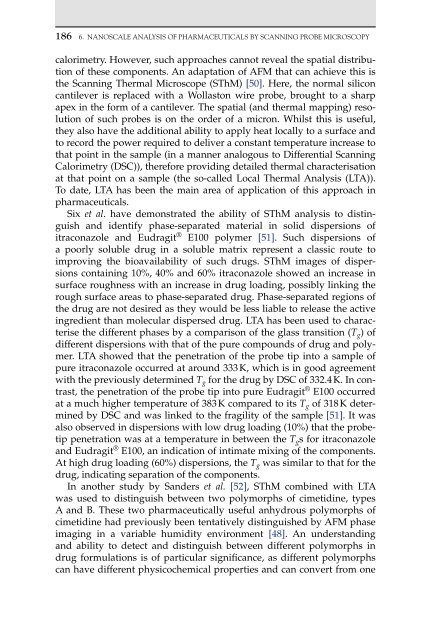W. Richard Bowen and Nidal Hilal 4
W. Richard Bowen and Nidal Hilal 4
W. Richard Bowen and Nidal Hilal 4
- No tags were found...
You also want an ePaper? Increase the reach of your titles
YUMPU automatically turns print PDFs into web optimized ePapers that Google loves.
186 6. NANOSCALE ANALySIS Of PHARMACEUTICALS by SCANNINg PRObE MICROSCOPy<br />
calorimetry. However, such approaches cannot reveal the spatial distribution<br />
of these components. An adaptation of AFM that can achieve this is<br />
the Scanning Thermal Microscope (SThM) [50]. Here, the normal silicon<br />
cantilever is replaced with a Wollaston wire probe, brought to a sharp<br />
apex in the form of a cantilever. The spatial (<strong>and</strong> thermal mapping) resolution<br />
of such probes is on the order of a micron. Whilst this is useful,<br />
they also have the additional ability to apply heat locally to a surface <strong>and</strong><br />
to record the power required to deliver a constant temperature increase to<br />
that point in the sample (in a manner analogous to Differential Scanning<br />
Calorimetry (DSC)), therefore providing detailed thermal characterisation<br />
at that point on a sample (the so-called Local Thermal Analysis (LTA)).<br />
To date, LTA has been the main area of application of this approach in<br />
pharmaceuticals.<br />
Six et al. have demonstrated the ability of SThM analysis to distinguish<br />
<strong>and</strong> identify phase-separated material in solid dispersions of<br />
itraconazole <strong>and</strong> Eudragit ® E100 polymer [51]. Such dispersions of<br />
a poorly soluble drug in a soluble matrix represent a classic route to<br />
improving the bioavailability of such drugs. SThM images of dispersions<br />
containing 10%, 40% <strong>and</strong> 60% itraconazole showed an increase in<br />
surface roughness with an increase in drug loading, possibly linking the<br />
rough surface areas to phase-separated drug. Phase-separated regions of<br />
the drug are not desired as they would be less liable to release the active<br />
ingredient than molecular dispersed drug. LTA has been used to characterise<br />
the different phases by a comparison of the glass transition (T g) of<br />
different dispersions with that of the pure compounds of drug <strong>and</strong> polymer.<br />
LTA showed that the penetration of the probe tip into a sample of<br />
pure itraconazole occurred at around 333 K, which is in good agreement<br />
with the previously determined T g for the drug by DSC of 332.4 K. In contrast,<br />
the penetration of the probe tip into pure Eudragit ® E100 occurred<br />
at a much higher temperature of 383 K compared to its T g of 318 K determined<br />
by DSC <strong>and</strong> was linked to the fragility of the sample [51]. It was<br />
also observed in dispersions with low drug loading (10%) that the probetip<br />
penetration was at a temperature in between the T gs for itraconazole<br />
<strong>and</strong> Eudragit ® E100, an indication of intimate mixing of the components.<br />
At high drug loading (60%) dispersions, the T g was similar to that for the<br />
drug, indicating separation of the components.<br />
In another study by S<strong>and</strong>ers et al. [52], SThM combined with LTA<br />
was used to distinguish between two polymorphs of cimetidine, types<br />
A <strong>and</strong> B. These two pharmaceutically useful anhydrous polymorphs of<br />
cimetidine had previously been tentatively distinguished by AFM phase<br />
imaging in a variable humidity environment [48]. An underst<strong>and</strong>ing<br />
<strong>and</strong> ability to detect <strong>and</strong> distinguish between different polymorphs in<br />
drug formulations is of particular significance, as different polymorphs<br />
can have different physicochemical properties <strong>and</strong> can convert from one
















